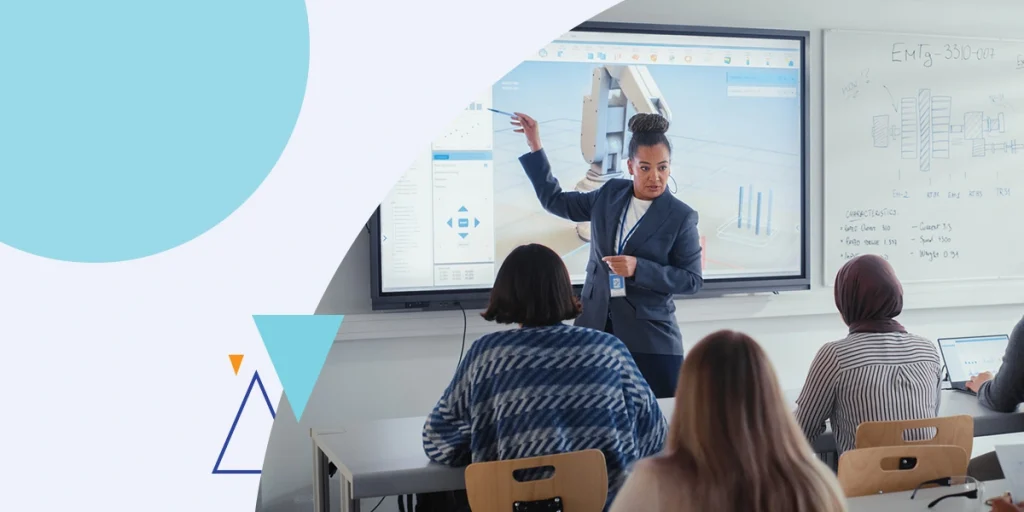
Every higher education institution’s information technology (IT) department has a vital role in today’s academic landscape. With unparalleled access to institutional data and the influx of online learning, colleges and universities have the increasingly complicated task of managing and protecting robust tech stacks.
We are breaking down the ins and outs of implementing, utilizing, and overseeing your institution’s digital tools to optimize their benefits and set your school up for long-term success. Learn more with this higher education technology management guide.
What is technology management in higher ed?
Colleges and universities can leverage advanced technologies for both academic and administrative functions, helping increase operational efficiency and improve academic quality. Managing tech infrastructure involves various processes to ensure the smoothest experience for administrators, students, and faculty.
Learn more about the primary responsibilities of technology management in higher education below:
Planning
IT management in higher education requires strategic planning to ensure technology utilization aligns with your college or university’s overarching mission and vision for the future. Schools must carefully develop their tech budgets and roadmaps to ensure:
- Scalability.
- Compliance.
- Security.
- Reliability.
Implementation
Your institution’s tech infrastructure likely includes networks, software, devices, and servers. Integrating these systems is an important part of optimizing technology management practices to enable streamlined data transfer and interoperability. Proper implementation and integration allow for better collaboration across campus and more insight into your institution’s overall operations.
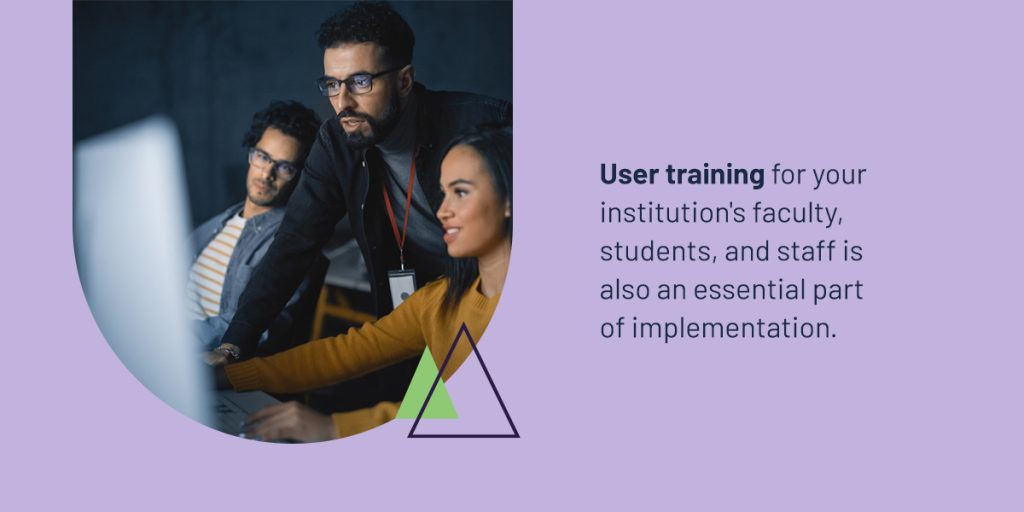
User training for your institution’s faculty, students, and staff is also an essential part of implementation. Fostering a culture of digital literacy, security, and continuous improvement makes technology management more seamless.
Maintenance
Maintenance is integral to maximizing the benefits of your institution’s tech stack. Part of maintenance involves harnessing relationships with tech vendors, monitoring performance and ensuring your solutions meet quality standards and move the needle toward your institutional mission.
Another important element of technology maintenance is risk management. Every college and university should prioritize a strong cybersecurity posture to mitigate threats, breaches, and failures. IT professionals must continuously monitor attack surfaces and implement new security measures when necessary.
The importance of robust higher education technology management
Proper technology management is essential for higher education institutions in today’s hyper-digitalized academic landscape. Explore the importance of implementing robust management practices below:
Enhanced education and instruction
Tech revolutionized the capabilities of higher education. Leveraging the right solutions and establishing a strong management structure can help your institution deliver more advanced and comprehensive educational experiences. Technology facilitates innovative teaching tactics and personalizes learning to suit each student’s unique needs. It also enables your students and faculty to access a massive volume of educational resources with little effort.
Effective technology management ensures your college or university’s faculty and students have the tools they need to maximize educational quality.
Student engagement and retention
Today’s students have high expectations when it comes to technology in higher education. Your college or university can utilize tech solutions to boost engagement by leveraging the capabilities of:
- Artificial intelligence (AI).
- Machine learning.
- Personalization.
- Automation.
- Data processing.
These tools enable higher education institutions to deliver cutting-edge academic experiences that can inspire higher student retention and graduation rates. Technology also offers greater insight into student performance and risk factors, so your institution’s teaching staff and advisors can proactively intervene when learners require additional attention.
Operational efficiency
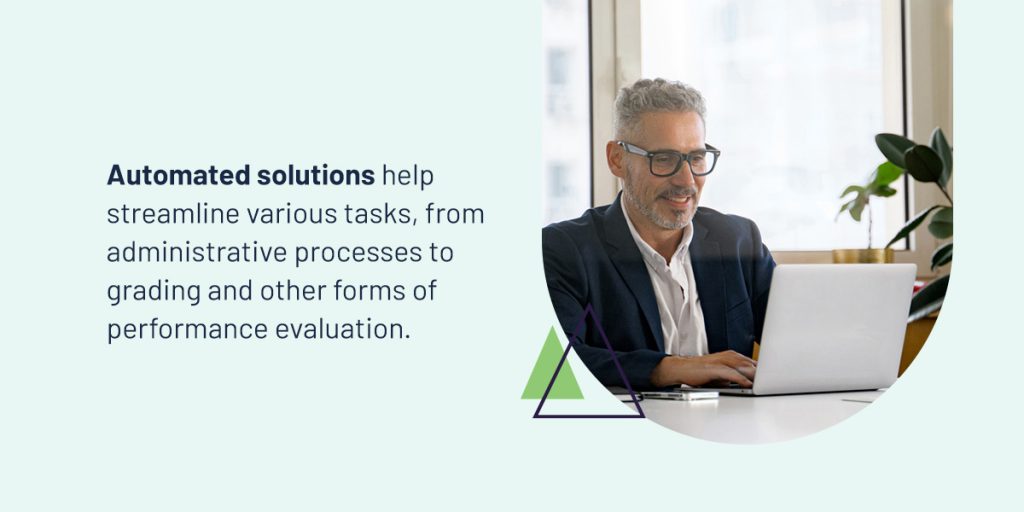
Another important aspect of robust technology management is maintaining optimized operational efficiency across campus. Automated solutions help streamline various tasks, from administrative processes to grading and other forms of performance evaluation.
Thanks to automation, your faculty and administration can delegate many routine tasks to tech, freeing up valuable time, money, and resources for other essential areas of your higher education institution. Technology also enables faster, more efficient communication between people and systems, leading to greater productivity.
Data-driven decision-making
With proper technology management, your college or university can make more strategic, data-driven decisions to foster institutional resilience, growth, and success. The right practices ensure that your higher education institution collects and stores student and faculty performance data so that it is easy to access and analyze for future planning.
Data is an incredible tool for assessing your operations, finding opportunities for improvement, and evaluating the effectiveness of new initiatives across campus.
Collaboration and connectedness
Your institution’s technology management practices also help enhance communication between people, platforms, and systems. The goal is to create the most efficient, reliable workflows possible to support streamlined collaboration on campus and remotely.
As online learning becomes increasingly more commonplace, a solid technological foundation and roadmap are key to fostering remote academic success and connectedness in higher education. A secure connection is also integral.
Cybersecurity
Another key reason for robust technology management in higher education is cybersecurity. Your institution has a lot of private and personal data about its students and faculty members that must remain secure and protected for the sake of your community, operations, and reputation.
Advanced cybersecurity and data protection tools are a necessity in today’s volatile digital landscape, especially as experts anticipate a spike in cybercrime in the coming years.
Innovation and adaptability
Technology plays a huge role in the evolution of your higher education institution. Proper management practices will help your college or university foster greater innovation and adaptability to accommodate the following:
- Changing educational trends.
- Diverse student needs.
- New job market and industry demands.
Through effective technology management, your institution can cultivate a culture of innovation that enables your college or university to stay ahead of the curve. Keeping up with the times is integral to supporting positive technology-enhanced learning, attracting top talent, and optimizing efficiency at every level.
Major technology systems in higher education
Different technologies allow institutions like yours to function at their peak efficiency while delivering a higher-quality academic experience. Learn more about the key educational technology systems that colleges and universities can leverage to their benefit below:
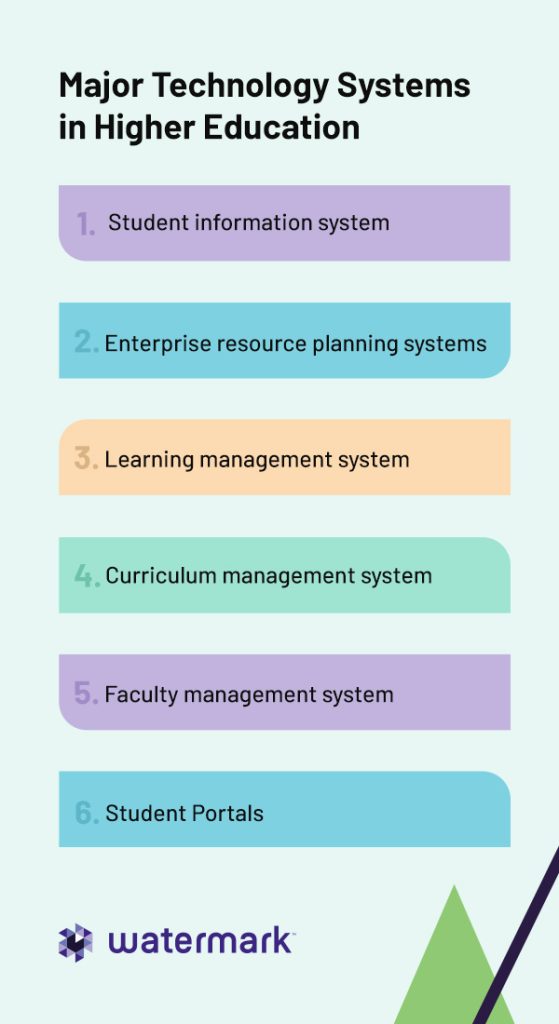
1. Student information system
A student information system (SIS) refers to a central database that congregates student-related data, including:
- Enrollment.
- Class schedules.
- Attendance.
- Grades.
These systems make it easier to track student progress and learning outcomes, helping ensure your institution’s academic programs meet high standards and support early intervention for struggling learners.
An SIS can help your institution provide personalized learning support services and boost learning experiences. The software often integrates with other platforms, such as a learning management system (LMS), to support better data flow. SIS tools can also enable easier regulatory compliance efforts by housing and enabling easy access to important student records.
2. Enterprise resource planning systems
Enterprise resource planning (ERP) systems are a powerful solution that can integrate many of your higher education institution’s administrative functions, including but not limited to:
- Procurement.
- Human resources.
- Daily operations.
Having all these tools in one online platform allows your institution to streamline its processes, saving time and money that your team can redirect toward other advantageous initiatives. A dynamic ERP also provides your college or university’s decision-makers with real-time insights to support better communication and strategic planning across your institution’s various departments and programs.
3. Learning management system
Another popular type of technology in higher education is a learning management system (LMS). These digital platforms allow for the following regarding your institution’s educational programs and courses:
- Delivery
- Management
- Assessment
LMSs enable better digital support and blended learning opportunities, an important feature for institutions looking to meet the demand for online education. They do so by providing your college or university with the tools it needs for everything from course content creation to collaboration across different departments.
A learning management system can also support personalized learning, allowing your institution to deliver more impactful and engaging educational experiences for students and faculty.
4. Curriculum management system
Your higher education institution may also utilize a curriculum management system to help with the design and management of your school’s academic programs. These platforms enable your department faculty to streamline each step in curriculum development, including:
- Planning
- Mapping
- Assessment
Having these tools for curriculum management is highly useful in ensuring alignment with your institution’s overarching goals and mission. Your faculty can closely monitor curriculum changes and student outcomes to determine the effectiveness and value of different programs. Integrations with other technologies, such as LMSs and SISs, can help establish curriculum coherence and increase the quality of your academic pathways.
5. Faculty management system
Your higher education institution may also utilize a faculty management system to track and store faculty-related information. These systems may house insights such as personal details, performance evaluations, and professional development progress.
The right faculty management solutions should:
- Streamline administrative tasks.
- Automate faculty workflows.
- Ensure institutional compliance.
- Track faculty performance.
These solutions play an important role in supporting faculty recruitment and retention initiatives. A quality faculty management system can also inform career advancement training and faculty resource allocation decisions.
6. Student Portals
Student portals refer to online platforms used to provide your higher education institution’s students with centralized access to administrative, academic, and support services. These digital solutions often feature personalized dashboards for students with self-service tools designed to help them streamline how they manage their educational journeys.
Student portals typically enable students to access:
- Grades earned.
- Course registration.
- Learning resources.
Some also allow users to communicate with their professors and classmates on a secure, streamlined platform.
Best practices for higher education technology governance and planning
How your institution uses and manages its technology solutions will have a huge influence on how they benefit your overall operations. Explore the following higher ed technology management best practices to learn how to maximize the impact of these tools:
Ensure technology aligns with your institutional goals
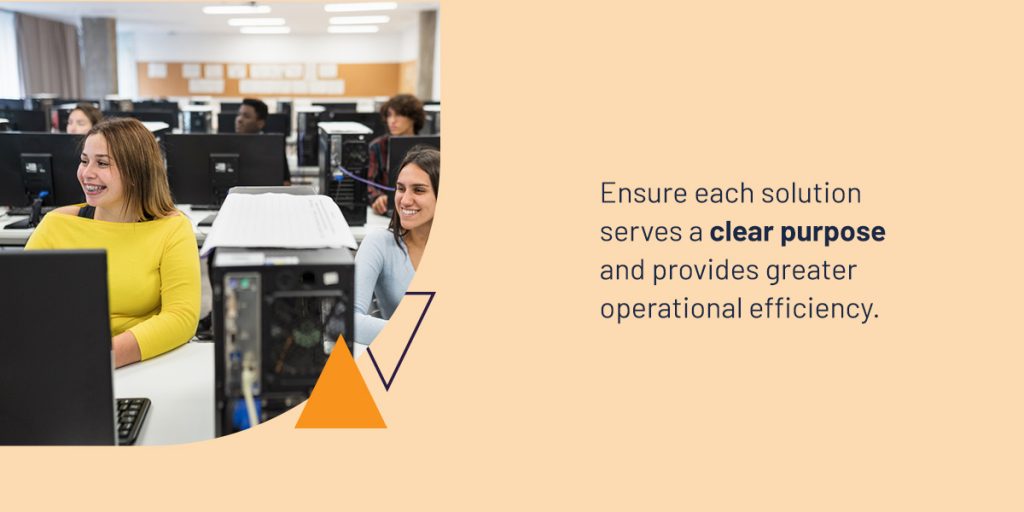
technologies your college or university invests in should always align with and positively contribute to your institutional objectives. Ensure each solution serves a clear purpose and provides greater operational efficiency. Your school’s tech has an important role to play — streamlining and simplifying manual tasks to help your institution deliver the best educational experiences for your students and faculty. If your technology is not helping your institution reach its goals, it may be counterintuitive to your mission.
Create a technology roadmap
By establishing a technology roadmap for your higher education institution, IT management teams can gain greater control of their tech governance structure for optimized decision-making and resource allocation.
Ultimately, developing this outline will help your institution assess its current technology capabilities and compare them with anticipated future needs and objectives. A comprehensive roadmap can help your team establish a clear vision of your institution’s short- and long-term goals for greater accountability and easier monitoring.
Establish data governance policies
An important best practice for higher education technology governance and planning is establishing policies for the following regarding institutional data:
- Access controls
- Security and privacy
- Quality standards
- Collection
- Storage
- Utilization
Higher education institutions can collect massive volumes of data, so prioritizing quality assurance can help you sort through the noise and find the insights that matter most to your mission. It is also integral to regulatory compliance.
Include your stakeholders
Inviting your stakeholders to participate in technology governance and planning is another best practice for higher education institutions. By including faculty, students, administrators, and IT staff in decision-making processes regarding new tech, your community will feel more seen, heard, and empowered.
Regular communication and ongoing feedback will provide your IT department with valuable insight into different user experiences across campus. Listening to your stakeholders can help your team determine which technology solutions best serve your institutional needs.
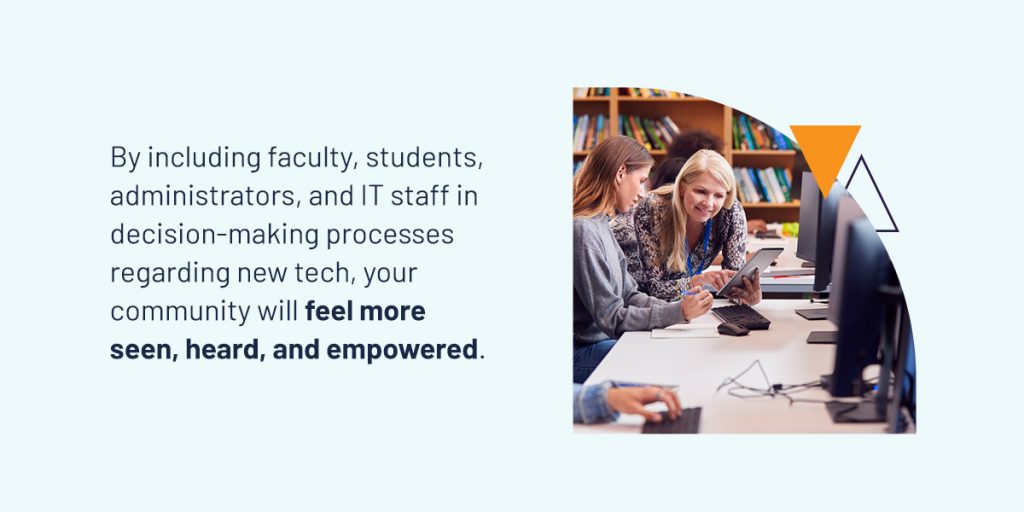
Prioritize risk management and professional training
The threat of cybercrime is too strong to ignore. Your college or university must prioritize a vigorous security posture and robust risk management techniques to minimize damage if a breach or attack occurs. Investing in cybersecurity training for your faculty, staff, and students can help reduce the probability of an incident.
Develop a plan for resource allocation
Another best practice for higher education technology management is establishing a clear budget and plan for resource allocation.
Starting with an assessment of your current and future tech needs will make it easier to establish a finite budget. Having a maximum spending limit helps your IT team prioritize the most beneficial digital tools, initiatives, or upgrades for your institution.
Evaluating technology vendors for higher education
As your college or university considers investing time and money into different solutions and technologies, it is important to assess the vendors your institution is working with. Before selecting a provider, explore the following:
Quality and reliability
When assessing different technology vendors, the first thing you should evaluate is the quality and reliability of their solutions. Learn more about the vendor’s reputation with other institutions and check out factors such as:
- Scalability.
- Performance.
- Uptime.
The tech providers you work with should offer products and services that support your college or university’s primary mission and vision for the future.
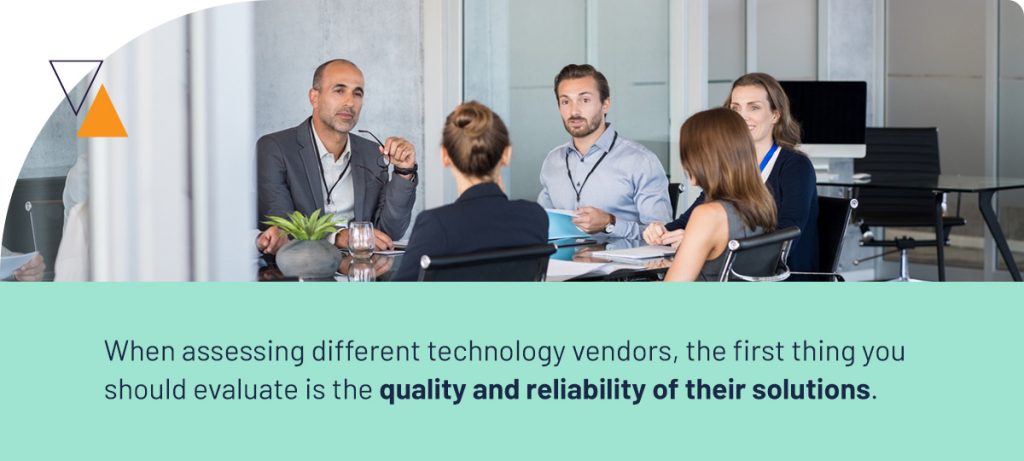
Support and maintenance
Another important factor to consider is whether or not a vendor offers support and maintenance services when your institution invests in its technologies.
Be sure to inquire about their technical support services in case an issue or disruption occurs. Some providers will offer extra advantages and opportunities, such as team training sessions and complementary software upgrades.
Costs and contract terms
Always assess the total cost of ownership for any technology acquisition. These costs may include:
- Upfront investments.
- Training expenses.
- Ongoing maintenance.
- Subscriptions fees.
Consult with your budget and resource allocation plan to determine which solution best suits your institutional needs and fits into your predetermined financial picture. Weigh the costs versus the capabilities your college or university gains from partnering with a new technology vendor.
Compliance and data security
A critical factor to consider when choosing a technology vendor is whether or not their products and services meet important compliance standards, such as the Family Education Rights and Privacy Act (FERPA) from the United States Department of Education.
Ensure you work with a provider that can also deliver strong data security and protect private information.
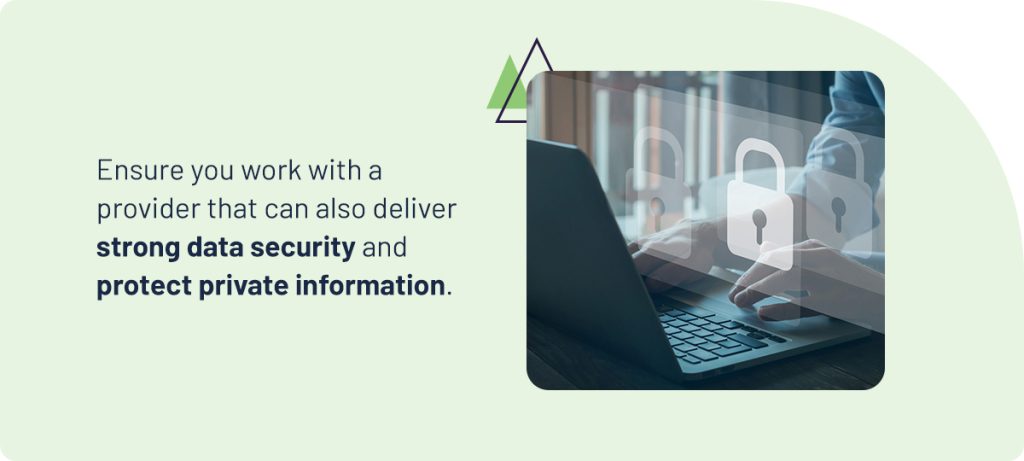
User experience
An important consideration for higher education institutions looking to partner with a tech provider is user experience. Select vendors with solutions that are easy to navigate and support intuitive workflows. Training programs may be necessary to foster a smooth adoption process and get the most out of these tools.
Assess the interface and ensure your students, faculty, and stakeholders can access resources for support and guidance if needed.
Future planning
Remember to consider your institution’s vision for the future when evaluating whether or not to work with particular vendors. Your technology needs to be scalable with your institution to meet changing needs over time. Ensure your vendor’s solutions are adaptable and flexible so your college or university can continue evolving and improving without worrying if your tech solutions can keep up.
Mastering technology implementation
An organized and strategic technology implementation process will help your institution successfully adopt new tools and reap greater benefits.
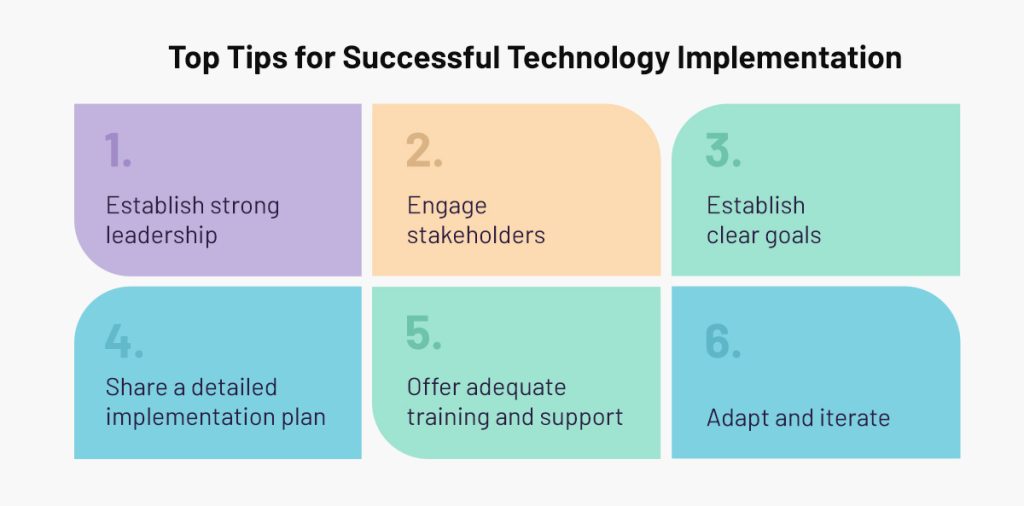
Explore some top tips for successful technology implementation below:
Establish strong leadership
Creating an IT leadership team can help your higher education institution harness greater control over technology implementation. Choose individuals who are enthusiastic about advancement and can provide guidance to other members of your community.
Strong leadership can spearhead implementation and guarantee that the process is organized and properly documented. This group will ensure the tech tools your school invests in are driving the needle and enhancing your institution.
Engage stakeholders
Another tip for making technology implementation successful is to engage all your stakeholders. Share the features and benefits of your institution’s technology with faculty, staff, and students. Ensure they understand the tool’s purpose and the problems it solves for your college or university.
The more they understand how the technology works and benefits them, the more open and willing they’ll be to adopt it.
Establish clear goals
Every technology you introduce to your higher education institution should have an obvious purpose and function in your operations. During implementation, consider establishing explicit goals for each of your tech solutions.
These goals should align with your institution’s strategic priorities and drive decision-making. Make these objectives clear and direct so you can easily gauge whether or not each technology is up to standard.
Share a detailed implementation plan
Another helpful tip for mastering implementation is to create a detailed plan that encompasses everything your community needs to know to support success, including:
- Timelines.
- Individual responsibilities.
- Milestones.
- Resources.
Compiling this information into a plan with various phases makes the entire process more manageable and organized.
Offer adequate training and support
Getting the hang of new technologies can take time. When introducing new digital tools to your college or university, be sure to account for comprehensive training programs and ongoing support.
Your faculty and staff will need to get used to utilizing the technology, so provide them with plenty of resources, accessible instruction, and opportunities to get more comfortable.
Adapt and iterate
Another important element of successful technology implementation is flexibility. Your users need to be adaptable and accommodating to the changing needs of your institution.
Encourage your administrators, faculty, and students to provide feedback and identify areas of improvement. Use these insights to refine your implementation process and continuously monitor progress to ensure your institution maximizes its technology’s benefits and serves its primary purpose.
Strategies for successfully training staff on new technology
Again, proper training is key to successful technology implementation. But how can your institution ensure its training programs will be effective and influential across your higher education community? Explore the following strategies for optimizing technology training initiatives:
Provide plenty of guidance and support

Be patient with your faculty members and administrators as they learn more about new technologies. Make your institution’s training programs as straightforward yet comprehensive as possible. Be sure to provide guidance and set clear expectations for each person. Share helpful resources, such as customer service numbers, online user forums, or a list of frequently asked questions with answers.
Role-based training
One way to make your training initiative more effective and engaging is to customize each person’s training based on their specific roles in your institution.
Different faculty members and students will require different technologies and capabilities to fulfill their particular responsibilities, so it is beneficial to train them on only the tools they will be using instead of having everyone learn how to use everything.
Share on-demand training materials
Consider developing and sharing on-demand training materials with your higher education institution’s community to make learning how to navigate new technologies easier. User guides, video tutorials, or step-by-step instructions can go a long way in helping people familiarize themselves with how to use new tools and features.
Find an accessible place to share these training materials, such as online or on your LMS, so individuals can reference them when needed.
Offer training in small groups
Offering training one-on-one or in small groups can be highly advantageous. Each person can receive individualized attention, making it easier to address concerns or questions.
Training in groups also allows for greater collaboration and time savings. As your people go through the materials, they can lean on their peers for help or consult with the instructor. Smaller sessions are also more manageable for trainers.
Incentivize training
If your higher education institution’s community does not seem very enthusiastic about training, consider implementing incentives to promote motivation and engagement. A little positive reinforcement can go a long way.
Find new methods for making training exciting. Use elements of gamification, like rewards or challenges, to inspire your students, faculty, and staff to become active participants.
Ask for feedback

Part of establishing an effective technology training program is asking for feedback and implementing new changes based on the user experience. Continuously solicit feedback from your stakeholders regarding:
- Training effectiveness.
- Improvement opportunities.
- Challenges.
Pay close attention to this feedback and use it to refine your program. As you make updates, your training programs should become more comprehensive, engaging, and informative.
How to easily maintain and manage your tech stack
Explore some of the top suggestions for streamlining tech stack management for your higher education institution below:
Regular assessments
Conducting routine assessments to evaluate the performance of your technology infrastructure will help your college or university closely monitor its important tools. The assessment should seek to identify:
- Security vulnerabilities.
- Compliance with relevant regulations.
- Areas for improvement.
- Overall efficiency.
- Potential issues.
Maintaining a healthy tech stack is key to optimizing the effectiveness of your digital solutions. Continuously analyze and track each tool’s performance. If a problem does arise, be sure to tend to it promptly and address any potential concerns before they result in operational disruptions or downtime.
Centralize your technology assets
Another helpful tip for making tech stack management and maintenance easier for your institution is to centralize and optimize your assets as much as possible. Doing so will simplify data management while increasing efficiency and tightening your cybersecurity posture.
Organizing your technology resources under one management structure will make it easier to keep track of everything from hardware and software to licenses and user accounts. With greater control over and insight into your institution’s tech stack, your team can make more informed decisions regarding upgrades and introducing new tools.
Prioritize updates and patches
One of the most important ways to streamline tech stack management is to stay up-to-date on all security measures. Ensure your college or university’s IT team implements a robust security process to:
- Identify any vulnerabilities.
- Address weaknesses quickly.
- Protect against serious cyber threats.
Your institution must prioritize current software patches, firmware upgrades, and software system updates to foster the safest, most secure technological environment across campus.
Leverage automation
Few tech tools are as useful and advantageous as automation. Your higher education institution can leverage it to streamline and simplify daily processes at the administrative, faculty, and student levels. Automation enables colleges and universities to enhance operational efficiency and tackle repetitive tasks so your community can save valuable time, money, and resources that can go towards achieving other important institutional goals.
Establish a disaster recovery and backup plan
Among the most beneficial tips for maintaining and managing your higher education institution’s tech stack is establishing a disaster recovery and backup plan. Having these plans in place is integral to ensuring academic continuity in case a cyberattack or system failure occurs.
Your team should develop and test a robust backup and disaster recovery plan to protect your institution’s critical data and minimize the negative impacts of a breach on your stakeholders.
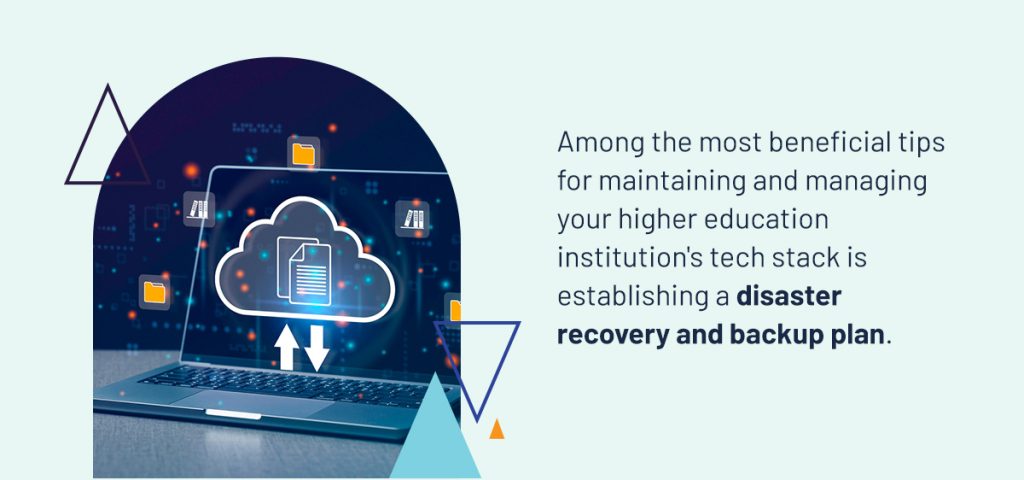
What to know about the importance of data privacy and security
Data privacy and security have never been more important for higher education. Your institution must prioritize strong, protective measures to ensure its tech stack is safe from unauthorized access and cybercrime.
The following are essential considerations for your college or university’s cybersecurity posture:
Protecting your sensitive data
Higher education institutions collect and store a massive amount of sensitive data, including but not limited to:
- Student records.
- Faculty details.
- Research findings.
- Intellectual property.
- Financial information.
Securing this data is key to protecting stakeholder privacy and combatting breaches that could compromise your community’s personal information.
Institutional trust and reputation
How your college or university handles cybersecurity and data privacy matters — one mishap can negatively impact your institution’s reputation and incite distrust.
Maintaining strong security practices will help your institution gain trust and confidence among your faculty, staff, and students. Your school should commit to protecting your institutional data as much as it commits to providing excellent academic experiences.
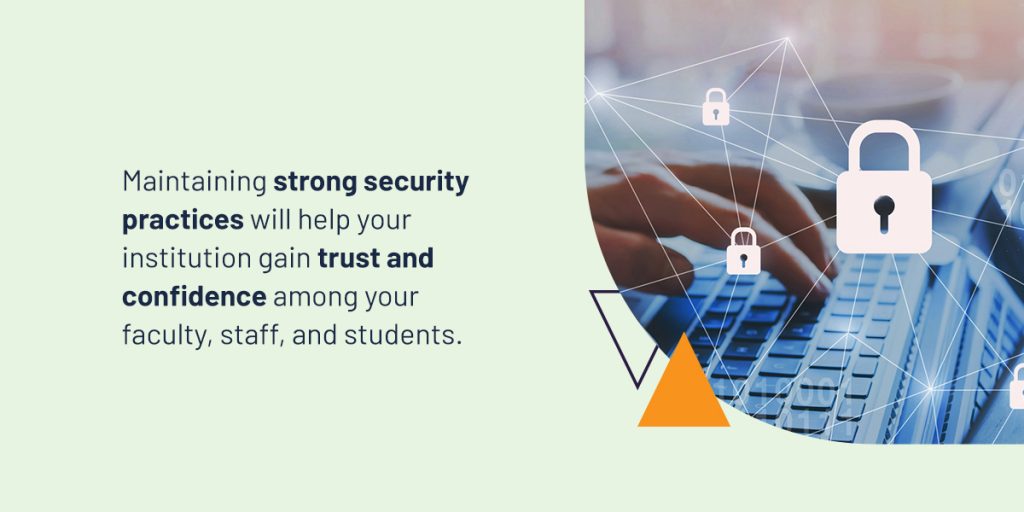
Cybersecurity awareness
Education is a massive part of a robust cybersecurity posture at your higher education institution. Your faculty members and students need to understand the best practices for preventing data breaches and other security incidents.
Training and instruction on cybersecurity awareness will help your community identify and mitigate risks, such as phishing attempts or social engineering attacks.
Systematic risk management
A comprehensive risk management strategy involving the following phases will help your higher education institution systematically mitigate threats:
- Identify potential risks.
- Assess vulnerabilities within your tech stack.
- Implement measures to enhance security.
- Monitor activity and assess effectiveness.
Keeping with this structure allows for greater organization and simplified risk management.
Legal and regulatory compliance
Remember that your college or university must comply with all relevant data protection laws and regulations when managing your institution’s technology. Failure to comply with these rules can lead to unfavorable legal consequences and financial penalties, as well as an impact on your institution’s credibility and reputation. Carefully assess and follow data regulations to ensure your higher education institution is protected against cyber threats.
How to future-proof your institution’s tech stack for long-term success
Technology is rapidly changing, and your higher education institution’s tech stack needs to keep up with the times to establish a competitive edge and continue serving your students with the best educational experiences possible.
Explore how to effectively future-proof your technology infrastructure to foster long-term growth and success below:
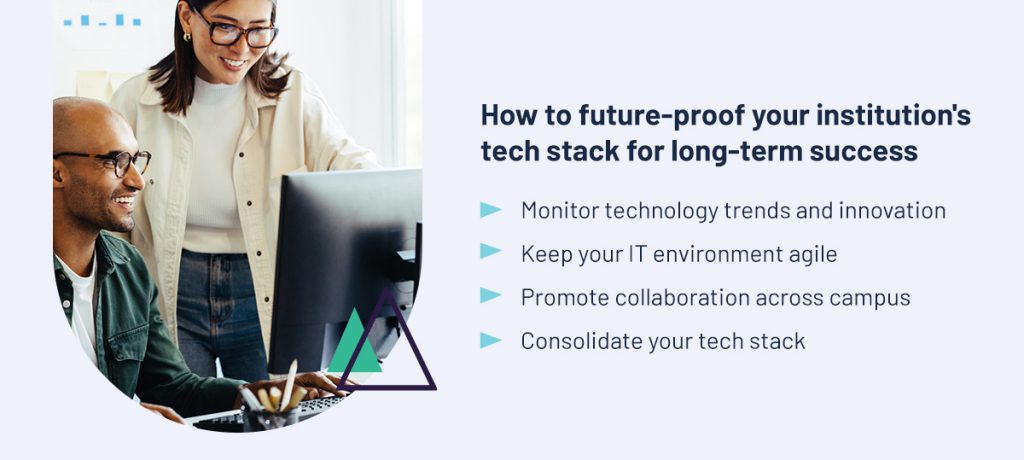
Monitor technology trends and innovation
Your college or university’s IT department needs to stay informed about the latest tech trends and innovations. They should monitor emerging higher education solutions and what other institutions are using to their advantage. Regular assessments of the newest tech tools will help your team determine which solutions are worth the investment for your institution and will leave a lasting impact.
Keep your IT environment agile
As technology evolves, your higher education institution’s tech stack must also adapt. Fostering an agile IT environment is key to quickly meeting requirements or introducing new solutions. This flexibility allows your college or university to embrace change and continuously enhance your tech infrastructure.
Promote collaboration across campus
Another way to future-proof your technology stack is to promote collaboration between various departments, programs, and campuses within your institution.
Collaborative efforts can help your school ensure that its technology aligns with its strategic goals and that your IT department understands the varying needs of different groups and disciplines. Establishing a culture of communication and connection can drive teamwork and innovation.
Consolidate your tech stack
Consolidation is one of the most advantageous ways for your higher education institution to future-proof its tech infrastructure. Digital sprawl can create division and impact the connectivity of different solutions, thus impacting your institution’s ability to harness the most efficient and effective communications.
By consolidating your tech stack and eliminating redundant tools or licenses, your school can enjoy the following benefits:
- Save time, money, and energy.
- Strengthen your cybersecurity posture.
- Simplify campus collaboration.
- Ensure students and faculty have the smoothest user experience.

Request a demo of the higher education software from Watermark today
If your higher education institution is interested in centralizing its technology, turn to Watermark’s Educational Impact Suite (EIS). With our solutions, colleges or universities can nix disjointed software that is complicating operations and putting them at risk.
Our EIS provides you with a centralized hub for carrying out your institution’s core processes, from assessment to accreditation to student success. It can integrate data from your SIS, LMS, or other Watermark products to paint a detailed picture of your institution’s current processes to inform decision-making and provide direction.
Are you interested in seeing Watermark’s Educational Impact Suite in action? Request a demo online and get started today.















































































































































































































































































































































































































